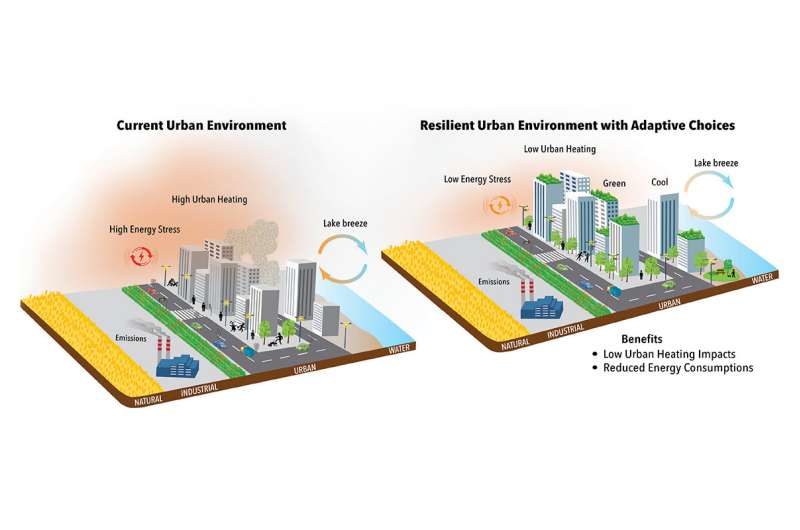Currently, Chicago has highly interdependent social, natural and engineered systems that contribute to heat stress, lack of green spaces, high greenhouse gas emissions and poor air quality. The city’s recent commitment to adopt climate mitigation strategies should lead to less heat stress, more green space and better air quality. Credit: Ashish Sharma
Last weekend, international negotiators approved the United Nations Glasgow Climate Pact at the 26th Conference of the Parties. Ashish Sharma, the Illinois research climatologist at the Illinois State Water Survey, spoke with News Bureau physical sciences editor Lois Yoksoulian about the takeaways from the COP26 and how the goals set at the global-level conference can be translated to the local level by U.S. cities.
What are the key takeaways from this year's COP?
Representatives from nearly 200 countries worldwide debated this latest round of climate talks. While negotiations to reduce emissions at the national level were promising, the progress has been slow, and we are not close to where we need to be on addressing climate change and controlling emissions. Commitments need to be converted to concrete actions and deliverables. Countries need green economic growth for infrastructure that prioritizes the fight against climate change. It means getting the Biden administration's "Build Back Better" bill across the finish line.
There seems to be a renewed sense of urgency regarding climate policy action. Why now?
Six years ago, we reached a consensus in Paris to keep the global temperatures within 1.5 C above pre-industrial levels to avoid catastrophic climate-induced impacts. However, we are already above 1 C because of the emissions we have added to the atmosphere and oceans.
It is a critical moment in history as Earth's recorded mean temperature has reached its new high. We are witnessing unprecedented disasters across the world. Surprisingly, even the rich countries are struggling to handle the wrath of climate change with increasing wildfires, floods, droughts and heatwaves.
For example, hurricane forecasters in the U.S. are running out of names for storms this year. Compounded climate events are not giving cities time to bounce back from vulnerabilities, e.g., cities in California facing wildfires and the Pacific Northwest stuck in heatwaves. Cities like Houston and New Orleans are struggling with increasingly heavier rainfall and much bigger hurricanes.
How can cities help achieve COP26 goals?
There is a parallel and accelerated effort to achieve these goals from the bottom levels of governance. Cities are stepping up and taking positive action to address the climate emergency, delivering targets and acting on those despite minimal financial support. The reason is simple—cities are most vulnerable to climate change. While country-level targets hesitate to convert to actions and deliverables, cities are taking on a leadership role.
Climate change acts as a threat multiplier to a city's infrastructure, economic development and public health. Moreover, cities are taking action because they can. Local governments are most responsive to constituents who are demanding climate action. Nimble and responsive governments also have unique authorities in land-use decisions that can create resilience and building codes that reduce energy demand and accelerate clean energy. Cities can take swift and decisive actions, and the solutions can be scaled with national and global support. Cities are providing the fuel to this new revolution that is now picking up.
What is an example of a U.S. city that is already implementing a successful climate action plan?
The Chicago Regional Climate Action Plan, to which I contributed, is a perfect example of a coalition of municipalities in the Chicago metro area that came together to develop climate mitigation and adaptation strategies that are locally focused. This plan provides a detailed roadmap to net-zero greenhouse gas emissions by decarbonizing energy sources and transportation, optimizing building energy and implementing clean energy policies by the year 2050—while incorporating equity and inclusion in climate adaptation planning. Such steps encourage cities to make immediate impacts and are positioned to lead, enact and encourage others to take actions on climate crises that are felt locally.
COVID-19 led to a lot of positive change, environmentally, in cities all around the world. Do you think we need crises to initiate policy change?
We need to consider climate change as a public health emergency and join forces as we are doing for COVID-19. We also need to keep asking ourselves these questions to align our actions with the clean, habitable urban utopia many have experienced for the last two years. I think we can accomplish this by investing in the right choices—rather than taking a reactive approach. We need to be smart and proactive in investing in renewables, thereby reducing carbon dioxide, methane and other emissions. Cities have taken charge and are leading by example.
Provided by University of Illinois at Urbana-Champaign
























